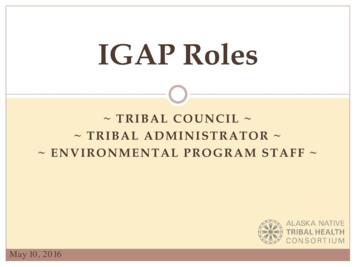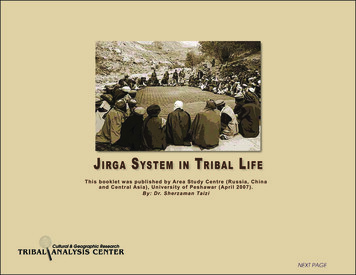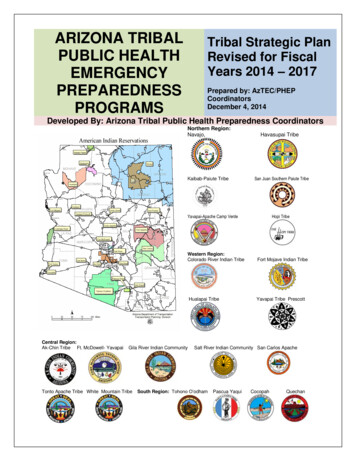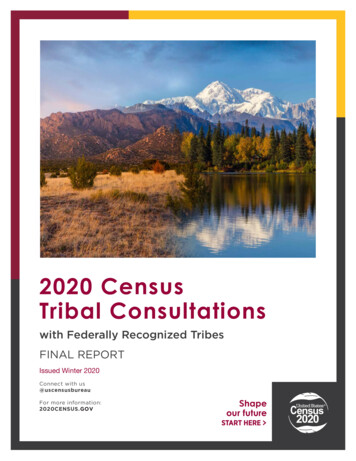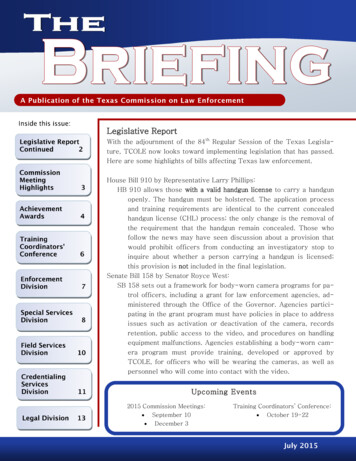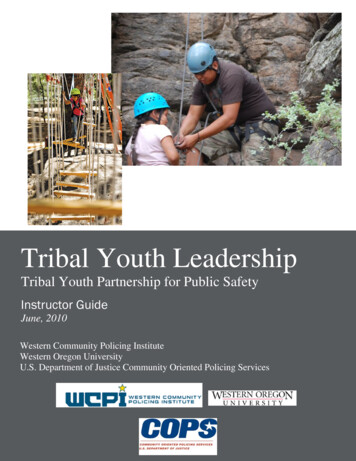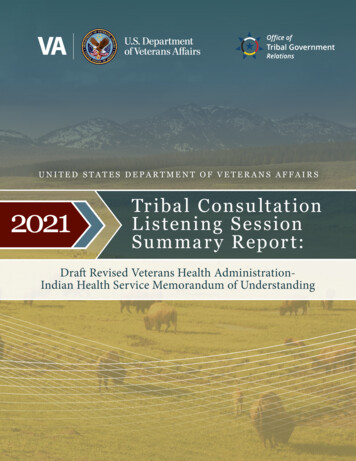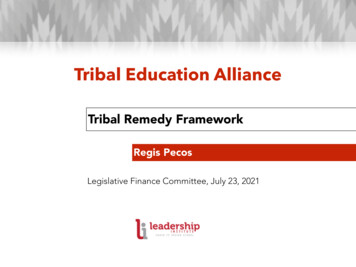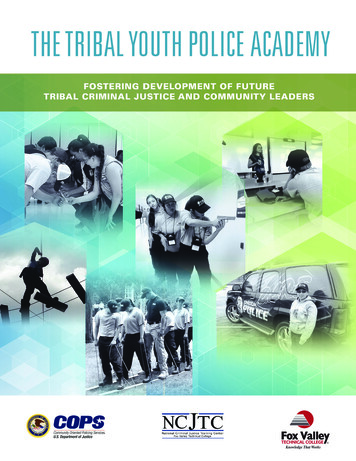
Transcription
2The Tribal Youth Police Academy
Chapteri
This project was supported, in whole or in part, by Cooperative Agreement Number 2013-HE-WX-K003awarded by the Office of Community Oriented Policing Services, U.S. Department of Justice. The opinionscontained herein are those of the author(s) or contributor(s) and do not necessarily represent the officialposition or policies of the U.S. Department of Justice. References to specific agencies, companies, products,or services should not be considered an endorsement by the author(s), the contributor(s), or the U.S.Department of Justice. Rather, the references are illustrations to supplement discussion of the issues.The Internet references cited in this publication were valid as of the date of this publication. Given that URLsand websites are in constant flux, neither the author(s) nor the COPS Office can vouch for their currentvalidity.Recommended citation:National Criminal Justice Training Center. 2020. The Tribal Youth Police Academy: Fostering Development ofFuture Tribal Criminal Justice and Community Leaders. Washington, DC: Office of Community OrientedPolicing Services.Published 2020
ContentsLetter from the Director of the COPS Office .vAcknowledgments . . . . . . . . . . . . . . . . . . . . . . . . . . . . . . . . . . . . . . . . . . . . . . . viiExecutive Summary . . . . . . . . . . . . . . . . . . . . . . . . . . . . . . . . . . . . . . . . . . . . . . . ixStatement of Need . 1TYPA staff . . . . . . . . . . . . . . . . . . . . . . . . . . . . . . . . . . . . . . . . . . . . . . . . . . 4TYPA students . . . . . . . . . . . . . . . . . . . . . . . . . . . . . . . . . . . . . . . . . . . . . . . . 7TYPA curriculum design . . . . . . . . . . . . . . . . . . . . . . . . . . . . . . . . . . . . . . . . . . . 8TYPA applicant selection process . . . . . . . . . . . . . . . . . . . . . . . . . . . . . . . . . . . . . 14Academy activities. . . . . . . . . . . . . . . . . . . . . . . . . . . . . . . . . . . . . . . . . . . . 15Methodology . 23Evaluation and Outcomes . . . . . . . . . . . . . . . . . . . . . . . . . . . . . . . . . . . . . . . . . . . 25Student pre- and post-academy comparison . 25Final pre- and post-academy comparison . . . . . . . . . . . . . . . . . . . . . . . . . . . . . . . . . 27Student community challenges . . . . . . . . . . . . . . . . . . . . . . . . . . . . . . . . . . . . . . 28Student post-academy interviews . . . . . . . . . . . . . . . . . . . . . . . . . . . . . . . . . . . . . 29Two-year follow-up interviews . . . . . . . . . . . . . . . . . . . . . . . . . . . . . . . . . . . . . . . 31Additional post-academy student testimonial . . . . . . . . . . . . . . . . . . . . . . . . . . . . . . . 34Student follow-up comments 2017 . . . . . . . . . . . . . . . . . . . . . . . . . . . . . . . . . . . . 35Recommendations and replication at the local level . 36Conclusions . . . . . . . . . . . . . . . . . . . . . . . . . . . . . . . . . . . . . . . . . . . . . . . . . . 39Appendix A. TYPA Agenda . . . . . . . . . . . . . . . . . . . . . . . . . . . . . . . . . . . . . . . . . . . 41Appendix B. TYPA Application Materials . . . . . . . . . . . . . . . . . . . . . . . . . . . . . . . . . . . . 46Appendix C. Student Pre-Academy Questionnaire . 49Appendix D. Student Post-Academy Questionnaire . . . . . . . . . . . . . . . . . . . . . . . . . . . . . . 51Appendix E. Pre- and Post-TYPA Comparison Community Challenges . . . . . . . . . . . . . . . . . . . . 53Appendix F. Pre- and Post-TYPA Evaluation Comparison of Career Choices . . . . . . . . . . . . . . . . . . 54Appendix G. Post-TYPA Top Three Youth Experiences . . . . . . . . . . . . . . . . . . . . . . . . . . . . . 55Appendix H. Parent Questionnaire and Responses . . . . . . . . . . . . . . . . . . . . . . . . . . . . . . 56
ivThe Tribal Youth Police AcademyAppendix I. Parent and Grandparent Comments from 2018 . . . . . . . . . . . . . . . . . . . . . . . . . . 59Appendix J. Mentor and Instructor Questionnaire and Responses . . . . . . . . . . . . . . . . . . . . . . 60Appendix K. Sample Youth Academy and Camp Program Partners . . . . . . . . . . . . . . . . . . . . . . 64Camp Triumph (Isleta Pueblo, New Mexico) . 64Camp Fury (Tucson, Arizona) . 65About the National Criminal Justice Training Center . . . . . . . . . . . . . . . . . . . . . . . . . . . . . . 66About the COPS Office . 67
Letter from the Director of the COPS OfficeColleagues:One of the major challenges facing the law enforcement profession is recruiting. Youth policeacademies serve a double purpose of providing young people a structured positive environmentand giving them early exposure to the idea of a career in law enforcement, thereby supporting lawenforcement recruitment efforts. Tribal police departments face at least the same recruitingchallenges as other law enforcement agencies, and Native American young people are generallyless likely than their peers in other demographics to consider careers in law enforcement—so boththese functions are especially important with respect to the youth and police departments in ourNative American communities.The National Criminal Justice Training Center of Fox Valley Technical College conducted a TribalYouth Police Academy in 2014 where they trained 41 young people in various law enforcementcomponents, including areas of particular relevance to tribal communities. This publicationsummarizes the activities of the academy and the students’ impressions of law enforcement bothbefore and after their time there—as well as their parents’ and teachers’ assessments of theacademy’s effects on them.A well-run youth police academy can be an important tool in giving teenagers a positive purposeand in increasing interest in law enforcement careers. Communities preparing to establish suchacademies will appreciate the guidance and recommendations to be found in this publication indeveloping and supporting their own academies and recruitment efforts.Sincerely,Phil KeithDirectorOffice of Community Oriented Policing Services
AcknowledgmentsThe National Criminal Justice Training Center of Fox Valley Technical College particularlywishes to thank U.S. Department of Justice Office of Community Oriented Policing ServicesDirector Phil Keith; Matthew Lysakowski, Senior Advisor for Tribal Affairs; and Melissa Fox,Senior Technical Editor.Publication development was possible through the time and dedication of many people. We thankall who participated in interviews and completed post-academy questionnaires.The publication development team included representatives from the National Criminal JusticeTraining Center of Fox Valley Technical College: Stephanie Bontrager-Ryon, Associate Lynn Chernich, Program Manager Julian Garcia, Associate Diana Mann, National Resource Development Manager Philip Schaefer, Program Specialist Joell Schigur, Program Administrator Justine Souto, Program Manager Ernest St. Germaine, ConsultantWe would also like to thank the many reviewers and editors for their suggestions and guidance.
Executive SummaryThis publication describes the Tribal Youth Police Academy (TYPA) conducted in 2014 by theNational Criminal Justice Training Center (NCJTC) under a cooperative agreement with the Officeof Community Oriented Policing Services (COPS Office), U.S. Department of Justice. In general,youth police academies are found to be positive and powerful experiences for youth.1 However, fewacademies are specifically tailored to the needs and backgrounds of Native American youth. Thegoals of the TYPA were to increase the interest of Native American youth (ages 14–17) in lawenforcement and criminal justice career pathways, serve as a recruitment tool for tribal lawenforcement and public safety agencies, foster positive tribal youth development, and buildleadership skills. Nationwide, Native American youth rarely develop an interest in entering lawenforcement or other criminal justice careers; yet there is a great need and a high demand for suchprofessionals. Programs such as TYPA are important to help tribal communities develop NativeAmerican law enforcement and criminal justice professionals to reflect and understand theircommunities and its needs.NCJTC implemented the TYPA at its facilities in Appleton, Wisconsin, in August 2014. Nine tribalinstructors and mentors and three staff members who were either enrolled tribal members orexperienced in facilitating tribal training programs led 41 tribal youth from 13 states in instructionaland hands-on TYPA activities. A one-to-five adult-to-student ratio was implemented because of thehands-on and sometimes physical nature of the curriculum. This ratio also allowed for ensuredsafety and more opportunity for personal attention. Learning activities were varied in nature andincluded tactical exercises, peer interaction, mentoring and coaching, lectures and presentations,talking circles,2 and personal reflection.Lecture and hands-on topics covered police procedures, crime scene investigations, tribal law,restorative justice and peacemaking, challenges unique to Native Americans, the role of communityresource and K-9 officers, and fire investigations. Special topical presentations concentrated onsuicide prevention, bullying, and alcohol and substance abuse. Another focus throughout thecurriculum was leadership development and confidence-building exercises such as a team-buildingchallenge course, Real Colors workshop,3 and public speaking exercise opportunities. The weekculminated in a simulated investigation where tribal youth oversaw a criminal case fromcommission to conviction. A graduation ceremony marked the successful TYPA completion.1. Samantha A. Goodrich, Stephen A. Anderson, and Valerie LaMotte, “Evaluation of a Program Designed to Promote Positive Police and YouthInteractions,” Journal of Juvenile Justice 3, no. 2 (2014), 55–71, https://www.ncjrs.gov/pdffiles/246951.pdf; Stephen A. Anderson, Ronald M.Sabatelli, and Jennifer Trachtenberg, “Community Police and Youth Programs as a Context for Positive Youth Development,” Police Quarterly 10, no.1 (2007), 23–40, 1106291372.2. Joseph P. Bohanon, “The Talking Circle: A Perspective in Culturally Appropriate Group Work with Indigenous Peoples,” Proceedings of the SixthNative American Symposium (Durant, OK: Southeastern Oklahoma State University, 2005), -the-arts-education-and-leadership/.3. Real Colors is a facilitated workshop used to improve and enhance participants’ personal and professional relationships. Real Colors, “History,”National Curriculum and Training Institute, Inc., accessed August 16, 2018, https://realcolors.org/what is realcolors/history/.
xThe Tribal Youth Police AcademyParticipating tribal youth completed a evaluations both before and after the TYPA. The data werecollected and analyzed to understand changes in youth’s knowledge and perceptions of themselvesand of law enforcement. Generally, participating Native American youth reported the TYPA to be apositive experience, and pre- and post-evaluation responses showed a “marked increase in learningwhat police do for the community.” Participating youth also indicated they were “more interestedin law enforcement careers.” Similarly, their parents, the instructors, and mentors completed aqualitative post-academy questionnaire to gauge their opinions of what the youth gained fromtheir TYPA experience. They, too, reported positive results including observed changes in the youthsuch as increased self-confidence and self-esteem, the application of gained leadership skills, anincreased sense of responsibility, and desire to further pursue a public safety–related career andhigher education. Full responses to the youth post-academy questionnaires can be found beginningon page 31. Instructor, mentor, and parent/guardian questionnaires can be found in appendices Hand J, and additional post-academy feedback submitted by parents and grandparents can be foundin appendix I. Suggestions and tips for how others could replicate a similar TYPA project are madeat the conclusion of this report.
Statement of NeedNative American youth face overwhelming challenges simply growing to adulthood; they live in“alarmingly high rates of poverty, homelessness, drug abuse, alcoholism, suicide, gangs andvictimization.”4 Within their individual lives, Native American youth experience what Joseph P.Gone calls a wounding across generations caused by massive group trauma and compoundingdiscrimination, racism, and oppression.5 Tribal youth further suffer “disproportionate rates ofpsychiatric distress” because of generational and historical trauma.6 They commit suicide at a rateone and a half times the national average for the age group 15 to 34.7In the midst of this harm and suffering, Native American youth also witness first-hand how NativeAmericans are “the racial group most likely to be killed by law enforcement.”8 So it is notsurprising that recruiting tribal youth into law enforcement and criminal justice professions isdifficult. “Police embody a system that reinforces the cultural oppression of Indigenous peoples andreprimands the use of their own institutions and traditional practices.”9Yet Native American communities across the country would greatly benefit from additional Nativepolice, court staff, corrections staff, legal defense, and related criminal justice and social servicesprofessionals serving them. Native American professionals can reflect and understand Nativecommunities’ experiences.10 They can help defuse tension, obtain cooperation from residents tosolve crimes, and help non-Native officers become more culturally competent.11 In addition, NativeAmerican law and justice workers can help facilitate a criminal justice system that tribal residentscan view as more fair and just while fostering conditions in which they themselves can moreeffectively and safely perform their jobs.124. Byron L. Dorgan and Joanne Shenandoah, “Ending Violence so American Indian Alaska Native Children Can Thrive,” Human Rights 40, no. 4(2013), ns/human rights magazine home/2014 vol th.html.5. Barbara Perry, Policing Race and Place in Indian Country: Over- and Under-enforcement (New York: Lexington Books, 2009).6. Joseph P. Gone, “Redressing First Nations Historical Trauma: Theorizing Mechanisms for Indigenous Culture as Mental HealthTreatment,” Transcultural Psychiatry 50, no. 5 (2013), 683–706, 1513487669.7. Rebecca Ahrnsbrak et al., Key Substance Use and Mental Health Indicators in the United States: Results from the 2016 National Survey on DrugUse and Health (Rockville, MD: Substance Abuse and Mental Health Services Administration, 2017), DUH-FFR1-2016/NSDUH-FFR1-2016.pdf.8. Mike Males, “Who Are Police Killing?” Center on Juvenile and Criminal Justice, last modified August 26, 2014, http://www.cjcj.org/news/8113.9. Erica Redner-Vera and Marcus-Antonio Galeste, “Attitudes and Marginalization: Examining American Indian Perceptions of Law Enforcementamong Adolescents,” Journal of Ethnicity in Criminal Justice 13, no. 4 (2015), 283–308, 014.984043?journalCode wecj20.10. Jeffrey Ian Ross and Larry Gould, eds., Native Americans and the Criminal Justice System: Theoretical and Policy Directions (New York:Routledge, 2015).11. Vanita Gupta and Jenny R. Yang, Advancing Diversity in Law Enforcement (Washington, DC: U.S. Department of Justice, le/900761/download.12. Gupta and Yang, Advancing Diversity (see note 11).
2The Tribal Youth Police AcademyThose seeking to attract more Native youth to law enforcement professions and to fostercommunication between tribal youth and police are encouraged to design and conduct Native-specificyouth police academy projects. For NCJTC, few published models and scant scholarly research existedfrom which to draw guidance. While some researchers have included Native Americans in their studiesof at-risk minority youth police academies, their findings do not take into account unique IndigenousNorth American cultures, languages, needs, and philosophies. More Native-centric research is neededon the practices and models of youth police academies and is strongly recommended.Interventions from other tribal youth programs and from non-Native youth police academies doprovide some guidance in developing police academies specifically for Native youth. Pearson(2009) asserts that tribal youth programs can be a healthy alternative to negative activities andbehaviors; they can result in fewer youth engaging in risky, sometimes illegal behavior and canhelp youth break the cycle of abuse. According to Pearson, guidance from caring adults helps tribalyouth learn trust and healing, and using Native culture and language can help tribal youth learnlife skills that can make a difference in a community and help strengthen them and their families.13A report from the Center on Standards and Assessment Implementation similarly stated thatculturally responsive instruction, the use of tribal language, and the involvement of tribal eldershave demonstrated positive academic benefits for Native youth in school settings.14One law enforcement youth project that actively recruits Native Americans is Camp TriumphSummer Youth Prevention Program, which uses a structured curriculum with emphasis onbuilding youth self-image, goal setting, and law enforcement mentorship—elements that were alsoincorporated into the TYPA. Camp Triumph is held in the Native American community of IsletaPueblo near Albuquerque, New Mexico. Law enforcement officers have said camp participantsacknowledge them outside the Pueblo with greetings and handshakes, while families noted howthey enjoy the bond their children developed with their mentors.Although not Native-specific, Camp Fury is another example of a youth camp model that focuseson inviting and engaging tribal youth in its region. Founded in 2009, Camp Fury is an innovativepartnership between public safety organizations and Girl Scouts that exposes teen girls to careers inpublic safety. Tribal members in the region are invited and strongly encouraged to participate.Participants learn search and rescue skills and crime scene investigation techniques, performphysical fitness drills, and are able to interact with women breaking down barriers and stereotypesin these male-dominated career fields. Camp goals include leadership skill development,teamwork, respect, and self-confidence. 1513. Gupta and Yang, Advancing Diversity (see note 11).14. Center on Standards and Assessment Implementation, Improving Educational Outcomes of American Indian/Alaska Native Students (SanFrancisco, CA: WestEd, 2016), I%20AIAN School Guidance Plan.pdf.15. “Camp Fury Celebrates Ten Years Training Girl Scouts as First Responders,” Girl Scouts of Southern Arizona, last modified May 29, /newsroom/2018/camp fury celebrates.html.
Statement of Need3Other youth police academies that are not specifically geared towards Native youth also haveelements that can be used in a TYPA or adapted to localized programs in Indian country. Manyhave found creative ways to identify and incorporate resources, partners, and funding. One suchprogram is the U.S. Department of Justice–supported Michigan State Police Youth LeadershipAcademy (MiYLA). Created in 2008, it is “regarded as an overwhelming success.”16 The program isheld at the Michigan State Police Academy and allows students to experience physical activities;military drills; water safety; awareness of alcohol and substance abuse, gangs, and domesticviolence; first aid; leadership; public speaking; interviewing skills; and other team building andleadership exercises. It also focuses on creating a mentoring relationship between youth and lawenforcement, with ongoing interaction after the academy.17Minnesota has a similar program called the Minnesota Youth Leadership Academy, a weeklongacademy that helps youth learn about jobs as state troopers and features a cop-to-kid follow-upmentoring program. It provides training on conflict resolution, community leadership building,and activities that promote self-confidence.18 In addition, the St. Cloud Youth Leadership Academyis part of the St. Cloud (Minnesota) Police Department’s Youth Initiative Program and modeled itsprogram after MiYLA, starting with a one-week camp and offering regular post-academygatherings and contacts between youth and police officers.19Another youth police academy program funded by the COPS Office, the Teens and Police ServiceAcademies (TAPS) in Houston, Texas, is a research-based mentoring program concluding that “themore time at-risk teens spend with police officers in a community policing atmosphere, such asTAPS Academy, social distance will decrease, elevating trust, support and assistance to lawenforcement agencies in the future.”20The Plano Police Crime Prevention Unit in Plano, Texas, allows participants in its Youth PoliceAcademy to role-play scenes as police officers so they can “experience a degree of the intensity feltby officers in the field.”21 The program has been called “a resounding success for the city, as well asthe teens who have participated, by sheer virtue of keeping the lines of communication open.”2216. Jeffeline Ermilus, “Michigan State Police Youth Leadership Academy,” Community Policing Dispatch 6, no. 5 (2013), p.asp.17. “Michigan Youth Leadership Academy (MiYLA),” Michigan State Police, accessed August 10, 2018, https://www.michigan.gov/msp/0,4643,7-123-72297 30536-271969--,00.html.18. Joy Powell, “Youth Leadership Academy Pushing Law, Order,” Minneapolis Star Tribune, October 7, 2009, y-pushing-law-order/63440477/.19. “St. Cloud Youth Leadership Academy (SCYLA),” City of St. Cloud, Minnesota, accessed July 25, 2018, -Academy-SCYLA.20. “Research and Resources,” Teen and Police Service Academy Center, accessed July 25, 2018, http://www.tapsacademy.org/Programs/Research.21. Rachel Welch Gomez, “Kids Learn about Cops: Plano Youth Police Academy Offers AdolescentsInside Look at Law Enforcement Jobs,” Nation’s Cities Weekly, March 13, 1995, https://www.thefreelibrary.com/Kids learn about cops%3a Plano Youth Police Academy offers adolescents.-a016778950.22. Gomez, “Kids Learn about Cops” (see note 21).
4The Tribal Youth Police AcademyThe Wilson, North Carolina, Youth Police Academy selects a different academy theme each year. In2014, the theme was life choices and the “consequences of poor choices, including alcohol, drugs,and gang activity.”23The Police and Life Academy For Youth was created in 2010 with university grant funds andfeatured an extensive partnership between state and city police, business community, local boosters,the City of Berkeley, and University of California at Berkeley. One participating youth said theprogram helped him “see all the different jobs within the police department.”24The Future Law Enforcement Youth Academy, created in 2016 by the New Haven, Connecticut,Field Office of the Federal Bureau of Investigation (FBI) and Yale University Police Department,promotes future law enforcement career paths for Connecticut youth.25 By grounding their programin dual sponsorship, organizers leverage their resources and enhance the program’s sustainability.The Tribal Youth Police Academy 2014 sought to incorporate elements similar to other successfulyouth academy program examples, such as those referenced above, while blending these approacheswith culturally relevant curricula and experiences and on a national invitation level. The ultimategoal was to provide Native American youth with exposure to law enforcement career-related andleadership skills to allow them the means to succeed and to make a difference in their communities.The remainder of this document summarizes the TYPA experience from planning to evaluation andoutcome identification and concludes with recommendations and considerations for replication atthe local level.TYPA staffThree NCJTC staff, including two Native Americans, conducted outreach to known tribal andcriminal justice professionals across the country to gauge their interest in participating in the TYPA.In total, NCJTC recruited nine tribal consultants as TYPA instructors and mentors. The consultantsand mentors acted as subject matter experts within their field and were committed to helpingstudents see the benefits of a career in criminal justice. These educators included current and retiredlaw enforcement professionals, a retired chief judge, a fire chief, and a community corrections officer.Table 1 on page 5 lists the TYPA staff and instructors who participated and their state/tribalaffiliations. Seven total tribes were represented.23. Olivia Neely, “A Different Course: Teens Learn about Law, Life during Youth Police Academy,” Wilson Times, July 17, olice-academy,59206?.24. “New Academy Connects Youth with Local Law Enforcement,” States News Service, September 24, 2010, . FBI New Haven, “Now Accepting Applications for FBI/Yale Future Law Enforcement Youth Academy Program,” press release, May 6, emy-program.
Statement of Need5Table 1a. TYPA 2014 staffNameTitleTribal affiliation (ifapplicable)Key areas of expertisePhilip SchaeferProject SpecialistJustine SoutoProgram ManagerOneida Tribe of Indians ofWisconsin, Oneida, WIStrategic planning, multidisciplinary teams, interventionand prevention programs,Native American cultureCary WaubanascumFormer Project SpecialistOneida Tribe of Indians ofWisconsin, Oneida, WISuicide prevention, alcohol andsubstance abuse, traumainformed careUse of force, defensive tactics,field training, bicycle patrol,community policingTable 1b. TYPA 2014 consultants and mentorsNameTitle/AgencyTribal affiliation (Ifapplicable)Key areas of expertiseErnest St. GermaineChief Judge (ret.),Lac du Flambeau Tribal CourtLac du Flambeau Band of LakeSuperior Chippewa Indians,Lac du Flambeau, WINative American cultures,tribal courts, restorativejustice, peacemakingCorrie JohnsonFire Chief, Kalispel Tribal FireDepartmentKalispel Tribe, WAEMT, emergency management,search and rescue, OSHAcomplianceSteven SkenandorePolice Officer / Field TrainingOneida Tribe of Indians ofOfficer, Las Vegas Metropolitan Wisconsin, WIPolice Department, NVField trainingJulian GarciaDetective, Tohono O’odhamNation Police Department, AZGangs in Indian country,defensive tactics, physicalfitnessRalph JeffersonRestorative Justice Director/Former Police Chief / InterimGeneral Manager, LummiNation, WALummi Nation, WATribal government, tribal law,police administrationMelanie TsadiasiSergeant, Zuni Tribal PoliceDepartment, NMPueblo of Zuni, NMSchool resource officer, policesupervisionDonovan TsadiasiProgram Manager &Community CorrectionsSupervisor, Zuni Tribal Police,NMPueblo of Zuni, NMCourt security, probation,community serviceCurtis FrancisVillage Public Safety OfficeCorporal, St. Mary’s PoliceDepartment, AKVillage of St. Mary’s, AKAlaska Native policingWarren WarringtonMaster Sergeant, MenomineeTribal Police Department, WIDrug courts, wellnessprograms, community policing
6The Tribal Youth Police Academy“We fed them and they were eating it up.”— Chief Judge (ret.) Ernest St. GermaineTYPA staff consultant and mentor, Ernest St. Germaine (Ojibwe), is a peacemaker, teacher, educator andwriter. In his role as tribal elder and role model, he led the TYPA talking/healing circles and reflections.Known as “Uncle Ernie” to many, retired Judge St. Germaine served as Chief Judge for the Lac du FlambeauTribal Court for 12 years and is an enrolled member of the Lac du Flambeau Band of Lake Superior ChippewaIndians.
Statement of Need7TYPA studentsThe 41 participating students represented 34 federally recognized tribes from 13 states. The vastmajority of the tribes were represented by one participant apiece, though three of the tribes wererepresented by two students and one tribe was represented by three students. Of the 41participants, 27 were male and 16 were female. Their ages ranged from 14 to 17 (15.5 was themean age). The represented tribes ranged from commonly known tribes like the Cherokee andNavajo nations to smaller tribes like the Kalispel Tribe a
NCJTC implemented the TYPA at its facilities in Appleton, Wisconsin, in August 2014. Nine tribal . instructors and mentors and three staff members who were either enrolled tribal members or . experienced in facilitating tribal training programs led 41 tribal youth from 13 states in instructional and hands-on TYPA activities.

